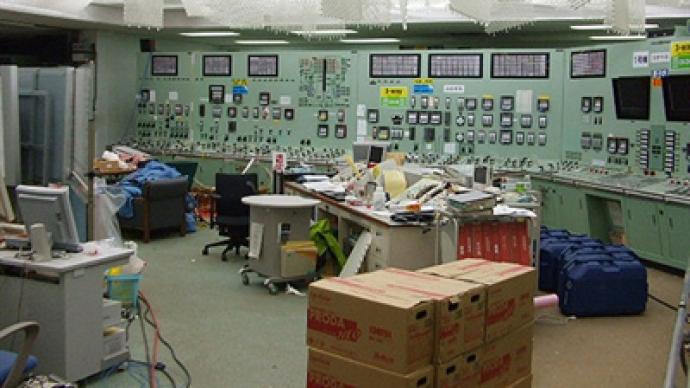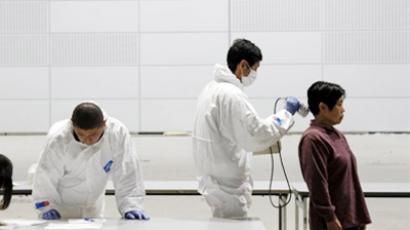Japanese authorities expand evacuation zone, cite no health risks

The Japanese government is debating whether to expand the evacuation zone around the Fukushima power plant, where water radiation is now 10,000 times higher than the norm. The evacuation area is currently 20 kilometers around the plant.
The authorities insist the measure to expand the evacuation zone is not because of health risks. Science experts, however, are painting a completely different picture.“There's been high levels of radiation detected out of the 20 km limit already. When you have radiation on that level, in a week or two you'll have people that are experiencing the radiation exposure of nuclear plant workers over the course of their career,” Dr. Robert Jacobs from the Hiroshima Peace Institute explains. “And these are people in a situation when there's been an earthquake, there's been a tsunami, there's a shortage of food and water. So these people should not be alone to remain in such an exposure area.”Because of the conflicting information people are receiving from various sources, the issue of who to trust has become prevalent in Japan.“People saw the explosion again and again on television and the government won't tell you for many hours what the hell is going on,” a member of the Liberal Democratic Party Diet Taro Kono told RT. “So the government should have been releasing information timely. They should tell you what's really happening. Now people are wondering if the government is telling you true stories.”At this point, the Japanese government is encouraging people to leave the territory voluntarily, Kyodo news agency quoted Japan's Chief Cabinet Secretary Yukio Edano as saying. Edano cited a shortage of basic supplies as the reason for the voluntarily relocation. ''The distribution of goods is stalled, and it is rather difficult to maintain daily living over a long period of time,'' he told a news conference. Yukio Edano added that the government will provide logistical assistance, transport and facilities for those moving further away from the troubled area. The government asked municipal services to prepare for a possible immediate evacuation of the citizens still staying in the area, should the necessity arise. In the first set of measures adopted shortly after the first blasts at the Fukushima facilities, the Japanese government ordered the evacuation of people living within 20 kilometers of the plant. Those living further in a 30 kilometer radius were advised to remain indoors.However, the latter have recently been experiencing increasing shortages in the supply of basic goods and food, as delivery companies are shunning the area for fear of radiation.Jan Haverkamp, an atomic power expert for Greenpeace, believes that the government's advice to those living close to the evacuation zone to voluntarily leave their homes has come too late.“Several organizations in Japan, including Greenpeace, already called on Sunday on the authorities to give this advice,” he told RT. “The authorities also gave this advice earlier [but] the advice is now stronger, because the chance that larger amounts of radiation could come out are still there, and people have been in their houses already for two weeks.”Haverkamp notes that it is, perhaps, time to start slowly comparing the Fukushima disaster with what happened in Chernobyl.“There are already calls for registering this as a [level] 7 event,” he said.
Japanese officials announced on Friday that a high-level radiation leak from Unit 3 of the plant detected on Thursday may signal that there may have been damage to the reactor’s vessels, pipes or valves, Kyodo news agency reports.As a result of the leak, two workers have been hospitalized with possible radiation burns.''At present, our monitoring data suggest the [Number 3] reactor retains certain containment functions, but there is a good chance that the reactor has been damaged,'' Hidehiko Nishiyama from the state Nuclear and Industrial Safety Agency told a press conference on Friday.Reuters has quoted TEPCO as saying that the radioactive materials could have leaked from Unit’s 3 cooling pool.Following the accident, authorities ordered the plant operator Tokyo Electric Power Co. (TEPCO) to improve radiation management at the facility.TEPCO is reported to be preparing for injections of fresh water into Units 1,2,3, and 4 of the plant instead of the seawater it used before. Seawater is believed to create a salt crust on the fuel rods, which prevents normal circulation of water, decreasing the cooling effect.Japanese Prime Minister Naoto Kan made a televised address on Friday, saying that the state of the Fukushima nuclear plant is still very precarious. He noted that although the situation is not getting any worse, it is still no time for complacency. The prime minister also apologized to the country’s farmers and businesses for damage caused by the Fukushima facility.According to AP news agency, radioactive traces have been found in raw milk, seawater and 11 kinds of vegetables grown in the areas surrounding the plant. Some countries are reportedly shutting exports of some goods coming from the troubled area. The Philippines have recently banned the import of chocolates containing milk coming from near the nuclear plant.Japanese police announced on Friday that the March 11 earthquake and tsunami killed over 10,000 people and left other 17,400 unaccounted for.According to AP, thousands of homeless pet cats and dogs are now wandering the rubble-filled streets in northern Japan in search of food and their masters. Some of the animals are trapped in the evacuation area surrounding the Fukushima power plant.
Events in Japan are on a catastrophic scale, says Robert Jacobs from the Hiroshima Peace Institute. “I think that the narrative that we have had for the last week or so, which is that ‘We are trying to fix the problem, get it under control’ is misleading,” he said. “I think that there is evidence of radiation having entered the environment, in large amounts. It is turning up in lots of places – in water, in food, it has even been detected far away in the food. It must have been present there a week ago if it is already turning up in milk and plants. What this could mean is that there is really a significant entry of radiation going into the environment right now.”“This is a situation, that is having a catastrophic impact currently already,” Jacobs added.














